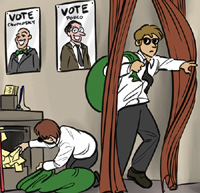 |
 |
 |
|
For More on the Special Elections:
• Staten Island’s North Shore • Staten’s Island South Shore • Central Brooklyn |
In special elections, held March 27, Demcrat Matthew Titone won the seat from Staten Island's North Shore and Republican Louis Tobacco won the seat from the South Shore.Democrat Micah Kellner is all set to go to Albany to represent residents of Manhattan’s East Side and Roosevelt Island in the New York State Assembly. He has won a raft of endorsements in his quest for the Democratic nomination, discouraged various rivals from running and, because of an overwhelming Democratic edge in the area, seems poised to defeat his Republican rival handily, whoever that might be. “It appears the race has already been decided,” said Susan Chamlin (in pdf format), one of several candidates who dropped out of the contest in the face of Kellner’s support from key party officials.
There is one problem: The seat Kellner hopes to occupy is still occupied, and no election is scheduled. Governor Eliot Spitzer has nominated the current incumbent, Alexander “Pete” Grannis, to be his environmental conservation commission, but the Republican-controlled State Senate has not confirmed him.
Whatever one thinks of Kellner, his anointment by party leaders again raises questions about the system of special elections for filling vacancies in New York State and city. While there is no special election scheduled for Manhattan, this Tuesday there will be special elections on Staten Island to fill two vacancies in the State Assembly. And next month, residents of the 40th City Council District in Brooklyn will vote once again – for the third time in less than six months – in a redo of a February special election whose results were voided when it became known that the winner, Mathieu Eugene, may not have met the legal requirement for residency in the district.
All this voting might appear to be a heady dose of democracy. But how much choice do voters in special elections really have?
In most of them, few eligible voters even know that the election is taking place. After all, who votes in March? A February State Senate contest in Nassau County attracted a huge amount of attention, including appearances by Governor Eliot Spitzer and former Mayor Rudolph Giuliani and a record $3.5 million in campaign spending. Even so, only 25 percent of eligible voters went to the polls, compared to 41 percent who voted in the same district in November.
In the legislative contests – as opposed to those for City Council -- the few people who do go to the polls will find that the field of candidates has already been narrowed by an arcane political process and the influence of political party leaders.
CHOOSING CANDIDATES
The whole system of choosing a party nominee and getting on the ballot in a special election for State Senate or Assembly is complex and inexplicable (if you really want the details, click here). In short, though, it comes down to this: A small number of party activists and insiders select their party’s nominee. There is no primary. Both the Democratic and Republican parties, along with the Working Families, Independence and Conservative parties – may field candidates. But in many legislative districts in the state, including the one on Manhattan’s East Side, one party or the other holds a huge edge in party registration. That party’s candidate starts special election day holding an enormous advantage.
The winner of this year’s special elections for legislature will have to face the voters again in a regular election in 2008. But given that incumbents have a nearly 100 percent reelection rate in New York, the victors have a good chance of serving a lifetime in their offices in Albany. According to figures compiled by Citizens Union Foundation (which publishes Gotham Gazette), 32 percent of the current members of the State Assembly and 29 percent of state senators first won their seats in a special election.
PLAYING THE GAME
Virtually no one defends the process. But even its critics use it to their advantage.
Last year Manhattan Borough President Scott Stringer called the system "ridiculous." At that time, voters on the West Side of Manhattan were about to go to the polls to choose a new member of the State Assembly – a vacancy created when Stringer won election to the borough presidency the previous November,
That opinion did not prevent Stringer from using the process to make sure that his favorite candidate, Linda Rosenthal, won the Democratic nomination. And it didn’t stop Rosenthal, who admitted that the “process may stink,” from accepting the nomination. While a few candidates waged a quixotic challenge against her, Rosenthal won – and remains in the Assembly.
There are exceptions. Last year, in the contest for another Manhattan Assembly seat, Sylvia Friedman, a longtime Democratic activist, got the Democratic nomination apparently due largely to her ties four local Democratic clubs.
Friedman’s victory was short lived. In a real Democratic primary – open to all registered party members not just club loyalists – she lost to Brian Kavanaugh, a former mayoral aide and chief of staff for Councilmember Gale Brewer. In beating Friedman, Kavanaugh pulled off the political equivalent of a baseball triple play – ousting an incumbent legislator.
THE PRICE OF DEMOCRACY
Like any elections, the special ones cost money for printing election materials and hiring and training poll workers. In City Council races, candidates get public funds to run their campaign. According to Citizens Union, the estimated cost of a special election in the city is $350,000 to $400,000.
THE NEXT ELECTIONS
The following special election have been scheduled:
-- Staten’s Island’s North Shore will elect a replacement for longtime Assembly member John Lavelle on Tuesday. The Democrat would normally be heavily favored in the contest but the presence of an Independence Party candidate, who unsuccessfully sought the Democratic nomination, could complicate things. The race could also bring Staten Island either its first openly gay state legislator or its first black elected official.
-- Staten Island’s South Shore: Also on March 27, voters will fill the seat formerly held by Vincent Ignizio, who was elected to City Council in February. This district is normally Republican, but the Democrats have sought to boost their chances by giving their party line to a registered Conservative Party member.
-- 40th Council District: Voters in central Brooklyn will again go to the polls to try to choose a successor to Yvette Clarke, who left City Council when she was elected to the U.S. Congress in November. In his continuing effort to become the first Haitian on the City Council, Mathieu Eugene, who won the first special election but apparently failed to meet residency requirements, will face a smaller and somewhat different field of opponents.
And if that’s not enough, there’s still that election on the East Side of Manhattan. Assuming Grannis eventually wins confirmation, Kellner, despite an impressive raft of endorsements, will still have to face the voters if he hopes to get to Albany.
Â




